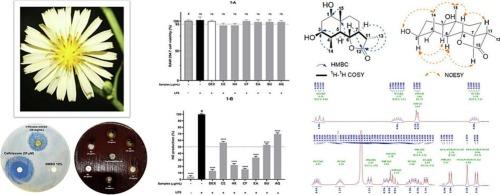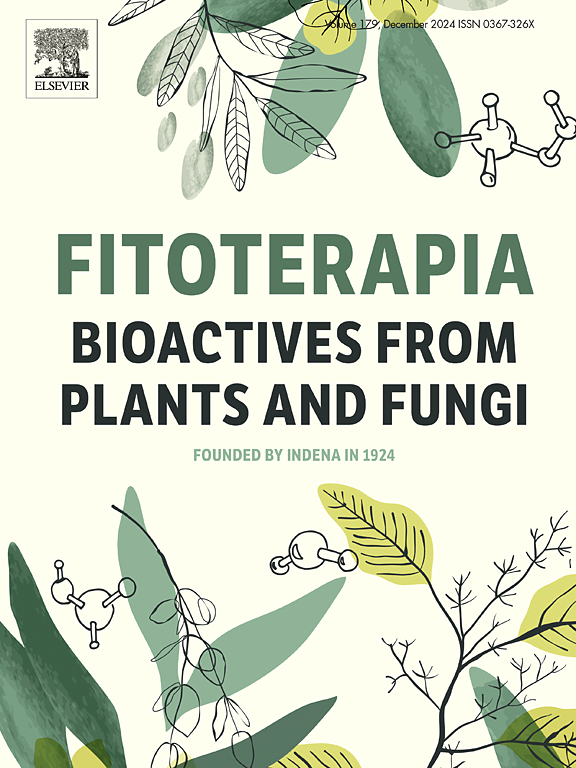Discovery of anti-inflammatory phytoconstituents from Lactuca indica L. based on its traditional uses
IF 2.6
3区 医学
Q3 CHEMISTRY, MEDICINAL
引用次数: 0
Abstract
The arial parts of Lactuca indica have been traditionally used to relieve skin inflammation or to alleviate stomach-ache. This study aims to evaluate pharmacological activities relating to traditional usage of the plant, with a special focus on anti-inflammatory, anti-bacterial and cytotoxic effects of extracts, followed by bio-activity-guided isolation of phytochemicals. The ethanolic extract was prepared by means of percolation, from which 5 sub-extracts were obtained by sequential liquid-liquid partition, including n-hexane, chloroform, ethyl acetate, n-butanol and aqueous sub-extracts. Through preliminary screening, the n-hexane, chloroform and ethyl acetate sub-extracts showed noteworthy inhibition on NO excessive synthesis in LPS-stimulated RAW 264.7 cells. Only the n-hexane sub-extract demonstrated anti-bacterial effect. None of the sub-extracts expressed cytotoxic effects on human acute leukemia (HL-60), hepatocellular (Hep-G2) or gastric (MKN-7) carcinoma cell lines. Phytochemical investigations of anti-inflammatory constituents were carried out for n-hexane, chloroform and ethyl acetate sub-extracts, leading to isolation of 12 compounds: stearic acid (1), glyceryl monostearate (2), β-amyrin acetate (3), oleanolic acid (4), lupeol (5), 4α(15),11β(13)-tetrahydroridentin B (6), 5-hydroxymethylfurfural (7), p-hydroxymethylbenzoic acid (8), protocatechuic acid (9), succinic acid (10), cynaroside (11) and lynarin (12). Molecular docking was then performed to investigate the underlying mechanism, revealing that four compounds 3, 4, 11, 12 exhibited excellent binding affinities to the iNOS enzyme. This study suggests that L. indica may be the source of promising phytochemicals against inflammation mediated by excessive production of NO. This could be a mechanism contributing to partly explain for traditional applications of this herb.

基于传统用途的乳香植物抗炎成分的发现。
乳香的arial部分传统上被用来缓解皮肤炎症或减轻胃痛。本研究旨在评估与该植物传统用法相关的药理学活性,特别关注提取物的抗炎,抗菌和细胞毒性作用,然后是生物活性引导下的植物化学物质分离。采用渗滤法制备乙醇提取物,经液液顺序分割得到正己烷、氯仿、乙酸乙酯、正丁醇和水相亚提取物5个亚提取物。经初步筛选,正己烷、氯仿和乙酸乙酯亚提取物对lps刺激的RAW 264.7细胞NO过度合成有明显的抑制作用。只有正己烷亚提取物有抗菌作用。这些亚提取物对人急性白血病(HL-60)、肝细胞(Hep-G2)或胃(MKN-7)癌细胞系均无细胞毒作用。对正己烷、氯仿和乙酸乙酯亚提取物的抗炎成分进行了植物化学研究,分离出12个化合物:硬脂酸(1)、单硬脂酸甘油(2)、醋酸β-amyrin(3)、齐ole果酸(4)、lupeol(5)、4α(15)、11β(13)-四氢鉴别素B(6)、5-羟甲基糠醛(7)、对羟甲基苯甲酸(8)、原儿茶酸(9)、琥珀酸(10)、cynaroside(11)和lynarin(12)。分子对接研究发现,化合物3、4、11、12与iNOS酶具有良好的结合亲和力。本研究提示,籼稻可能是有希望的植物化学物质的来源,抗炎症介导的过度生产NO。这可能是一种机制,部分解释了这种草药的传统应用。
本文章由计算机程序翻译,如有差异,请以英文原文为准。
求助全文
约1分钟内获得全文
求助全文
来源期刊

Fitoterapia
医学-药学
CiteScore
5.80
自引率
2.90%
发文量
198
审稿时长
1.5 months
期刊介绍:
Fitoterapia is a Journal dedicated to medicinal plants and to bioactive natural products of plant origin. It publishes original contributions in seven major areas:
1. Characterization of active ingredients of medicinal plants
2. Development of standardization method for bioactive plant extracts and natural products
3. Identification of bioactivity in plant extracts
4. Identification of targets and mechanism of activity of plant extracts
5. Production and genomic characterization of medicinal plants biomass
6. Chemistry and biochemistry of bioactive natural products of plant origin
7. Critical reviews of the historical, clinical and legal status of medicinal plants, and accounts on topical issues.
 求助内容:
求助内容: 应助结果提醒方式:
应助结果提醒方式:


